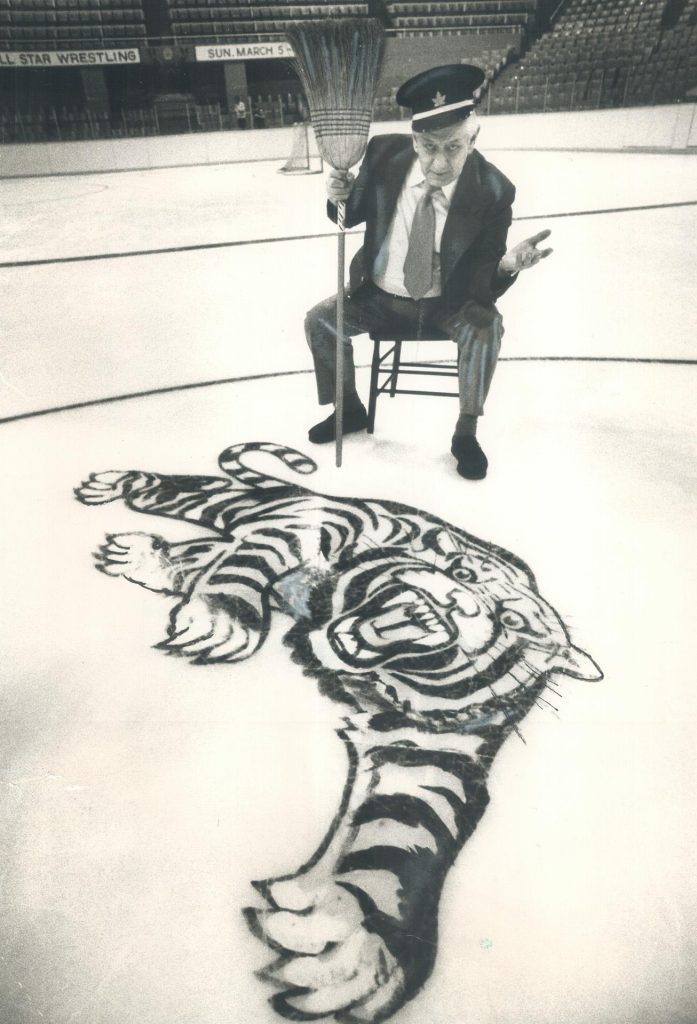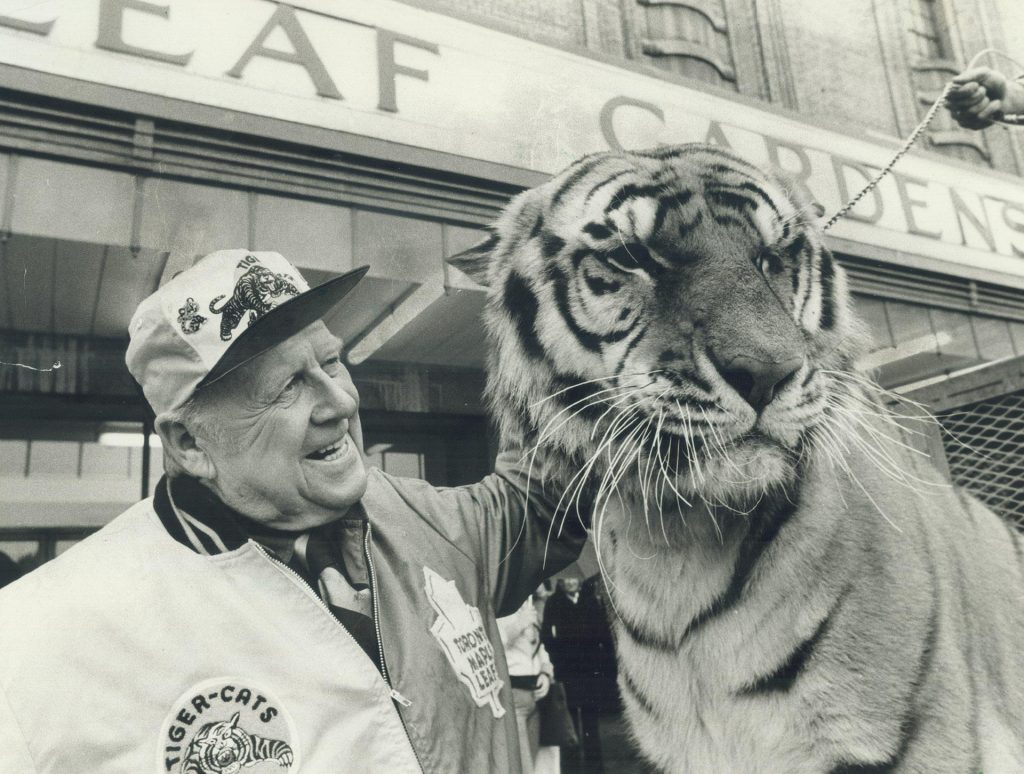Jason Priestley documentary on Harold Ballard brings up his Hamilton Tiger-Cats ownership
Published February 2, 2023 at 10:41 pm

A Grey Cup title for Steeltown might have been too little, and definitely came too late in the game of life for Harold Ballard, whom Jason Priestley has exhumed for a film about the infamously irascible sports mogul.
Priestley’s sports documentary Offside: The Harold Ballard Story, which debuted last month, loops in a new generation on the legendarily loopy overlord of sports and entertainment in Toronto. His shambolic governance of the Toronto Maple Leafs understandably takes up most of the film’s 89 minutes — as it should. Ballard’s stint operating the Hamilton Tiger-Cats blends in a bit of contrast — and perhaps the film’s saddest and most sympathetic moments.
Football was part of Ballard’s sporting consciousness. His son, Bill Ballard — who ran MLG while his father was in prison for fraud in the early 1970s — played offensive line at Waterloo Lutheran University (now Wilfrid Laurier). The family tried to get a Toronto CFL team — either the Argonauts or getting a new franchise.
The Ballard era in Hamilton lasted for 11 football seasons, from 1978 to ’88. He is remembered more kindly in that capacity than he was for hockey. The characterization at thecanadianencyclopedia.ca is that Ballard was “mostly a model owner in the CFL, putting performance ahead of profits.”
Some editing might be in store there. Offside, which is directed and narrated by Priestley, shows footage of Ballard watching a game in Hamilton and describing a player with the vilest racist slur, which would not fly in the 21st century. As cringe as that is, Ballard and his sidekick, hall of fame hockey player Francis (King) Clancy, were otherwise in their Statler and Waldorf-style glory watching from a box at Ivor Wynne Stadium or the “bunker” in the corner of the Gardens.
News footage from the victory parade after the Tiger-Cats won the Grey Cup in 1986 includes a TV reporter stating, “In Hamilton, they love their Tiger-Cats — and they even love Harold Ballard, the man everybody loves to hate.”
However, that 39-15 beatdown of Edmonton in the 74th Grey Cup at B.C. Place in Vancouver came on Nov. 30, 1986. That was only 22 days after the energy of Clancy had returned to the earth. As so often happens when older adults see a contemporary expire, the 83-year-old Ballard was perhaps confronted by his mortality.
“It was one of the saddest times I’ve ever seen Harold Ballard,” journalist John Iaboni says in Offside. “It was right after King Clancy died. He finally won a championship, and there was no one there for him to share it with.
“I took him downstairs for the (postgame) press conference, and he wasn’t himself,” Iaboni adds.
“He was in total shock that he actually won a championship.”
‘Moonshine girls’ outshone by Moon
Some Google deep-diving conjures up a sports promoter who really did want to win, as long as he could be the centre of attention. Trolling was not an everyday word in the lifetime of Ballard, but he used his ownership of the major sports teams in both Toronto and Hamilton to make the Argonauts his comic foil.
It is well-known that Ballard was given to having Tiger-Cats logos painted on the ice or the boards of the Gardens.

Now take 1980. The Tiger-Cats advanced to the Grey Cup, which was to be played in Exhibition Stadium in Toronto. (The Argonauts had missed the playoffs, running their championship drought to 28 seasons.)
They were up against two-time defending champion Edmonton, which (a) had future two-nation hall of fame quarterback Warren Moon and (b) had dusted Hamilton by 35 points in the teams’ lone regular-season matchup.
Ballard told the assembled media that he had already had Tiger-Cats players measured for Grey Cup championship rings. Tiger-Cats players were also invited to a Leafs game at the Gardens. As author (and former CFL quarterback) Frank Cosentino described it in his book Closed Doors and Alberta Crude, “messages of derision aimed at the Argos flashed on the electronic scoreboard” as the footballers were introduced to the crowd.
Then came the Grey Cup parade, where the Hamilton float flouted good taste and the idea of a good-natured rivalry. Per Cosentino, the float bore four “hairy-legged” University of Toronto male students dolled up in blue tights, construction boots, padded brassieres, wigs, lipstick and yellow sweatshirts reading “Moonshine Girls,” in a poke on the regular feature in the Toronto Sun newspaper.
There was also a eight-metre-high tiger statue, complete with a dummy in an Argonaut uniform stuffed in its jaws and another wrapped in its tail.
Ballard and Clancy rode along in a golf cart, to be eternally pictured enjoying themselves.
How that played into the Tiger-Cats mental game can only be known by those who were in the dressing room. The record shows that Edmonton and Moon won the game 48-10. They went on to win five titles in a row.
At least the Tiger-Cats were playing for a championship. Comparisons across different sports are chintzy, especially with the smaller size of the CFL.
Ballard wrested control of MLG and the Leafs in 1972 and was at the helm until he died in 1990. Over 19 winters of hockey discontent in Toronto, the Maple Leafs went to the semifinal stage of the Stanley Cup playoffs only once — and were swept by the Montréal Canadiens. They were 0-for-the-1980s in producing a winning regular-season record.
The Tiger-Cats did win that one championship with Ballard around. But the CFL was not exactly a winning play financially in those days.
Ballard picked up the Ticats in 1978 for $1.2 million (about $4.8 million today). That purchase occurred at a pinch-point for competition in the sports industry for advertising and attention in Canada which pancaked the CFL.
The nation jumped from three NHL teams to seven after the WHA folded and the Calgary Flames moved north from Atlanta. The Toronto Blue Jays, who began play in 1977, emerged as the nation’s first truly vertically integrated Major League Baseball operation.
The CFL did not exactly have the leadership to adapt to market changes. When Larry Smith became the league’s fourth commissioner in five years in 1992, he found out the CFL had all of one national sponsor. The recently departed television producer Roy Mellanby, who was born in Hamilton, once wrote of a couple of the league’s commissioners: “The fact they had played football for the University of Toronto didn’t quality them to run a league.”
Ballard was vocal about the Tiger-Cats being unprofitable. And that only made him want to win it more. Take what he said once after the curtain came down on a Tiger-Cats season with a come-from-ahead defeat against Ottawa in the East semifinal.
“I tried to sell it once but nobody would give me a quarter for it,” he told United Press International in an article dated Nov. 15, 1982. “Besides after losing that damn game Sunday, I am madder than ever. I won’t quit now.”
Well, he would not have been the first person, nor the last, who wanted something badly and was unable to fully enjoy it when it finally happened.

Threatened to move the Ticats to… Toronto?
It did not end well for Ballard in Hamilton. By 1988, he owed the city $300,000 in rent on Ivor Wynne Stadium, and claimed that MLG Ltd. had lost $20 million running the Tiger-Cats. Pressed on the rent, he had the team’s equipment packed up and threatened to move the team to Toronto — as baffling as it might seem in 2023 for Toronto to have two CFL teams when it seems like most of the city is unaware it has one.
By January 1989, Ballard was threatening to fold the team.
Businessman David Braley, though, was the financial saviour, who bought the team from MLG and Ballard in what was recorded as a $1-million sale. That is about $2.01 million in 2022 Canadian dollars, so Ballard essentially sold the team for less than half what it cost him a decade earlier.
Braley, whom the athletic centre and health sciences centre at McMaster University are now named after, might well have the biggest benefactor in the history of three-down Canadian football. Over his lifetime, he owned one-third of the teams in the CFL, and even paid the bills for the Argonauts and British Columbia Lions simultaneously, because CFL.
He was rightly remembered fondly when he died in October 2020. Ballard, dead for over 30 years, was simply memorable.
Overall, Priestley’s Offside, with dynamite drop-ins from a deep lineup of Leafs luminaries, former executives and sports media figures, including Hamilton resident and author Stephen Brunt, brings a new generation in on the whole circus that most Leafs fans age 45 and older have tried to forget, without the euphoria of a Stanley Cup victory to wash away the stain. Much of the content is familiar, but it is good to have a cautionary example of a saga that was never going to turn out well.
(Secondary photos: Toronto Public Library. Offside: The Harold Ballard Story is free to view on CBC Gem.)
insauga's Editorial Standards and Policies advertising





